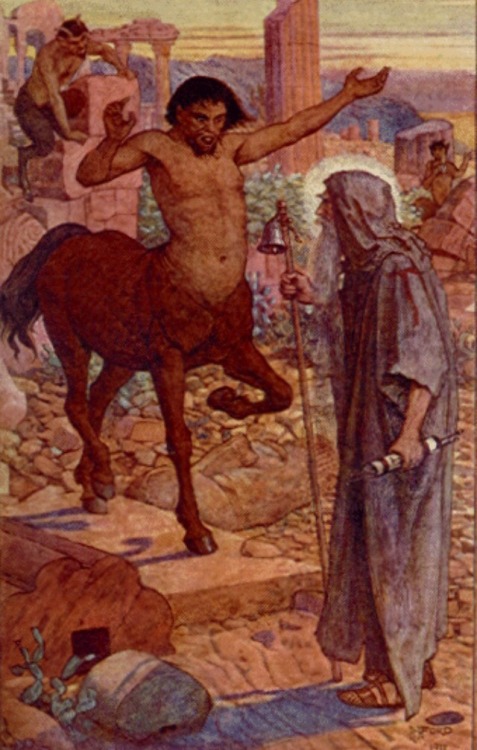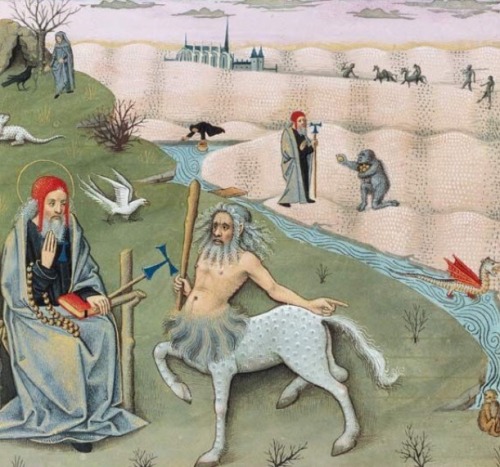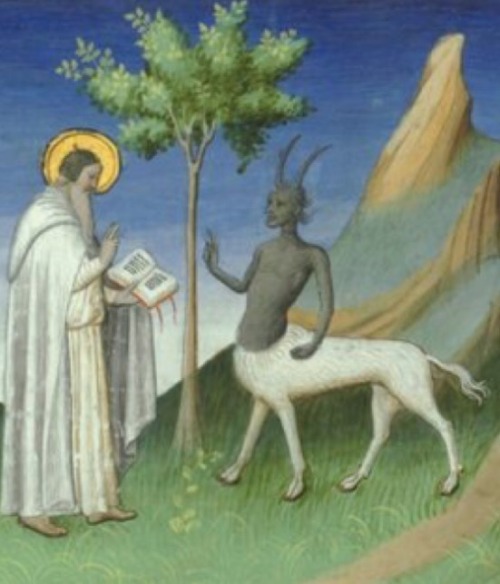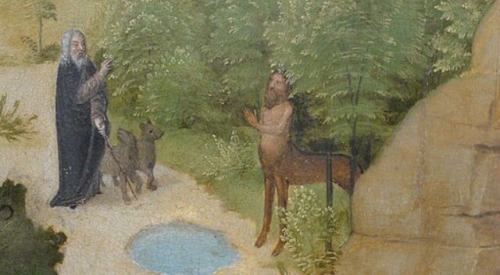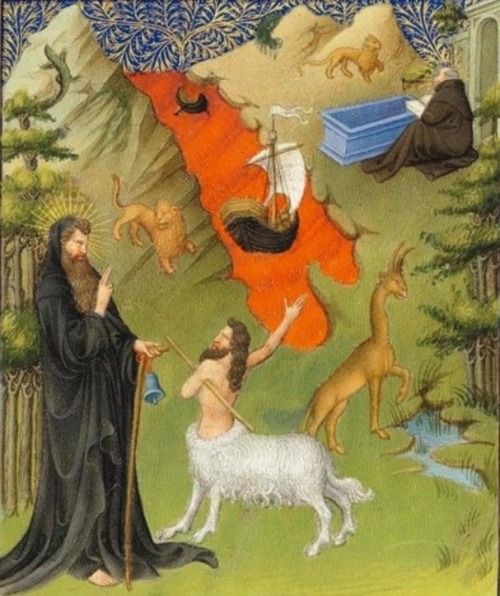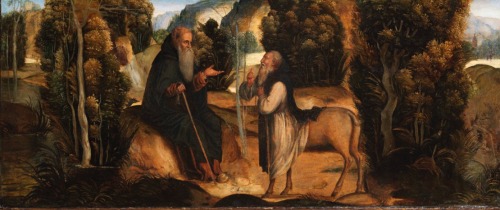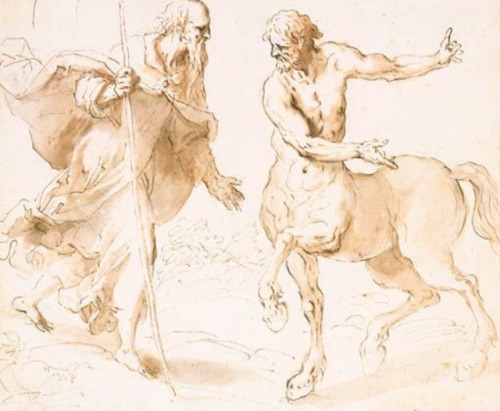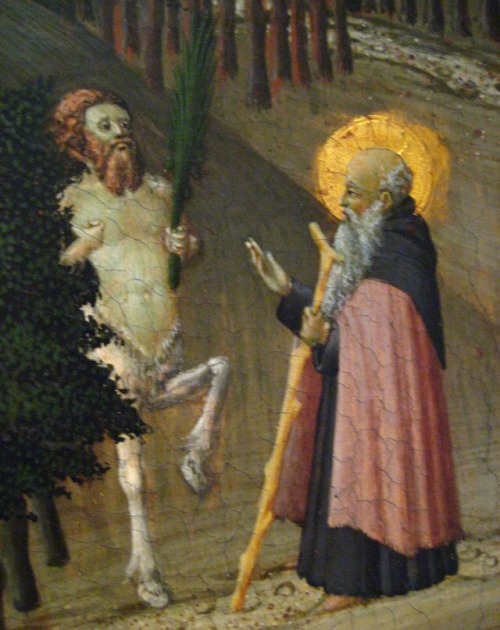religions-of-the-world: St. Anthony, the Centaur, and the Satyr (from the Life of St. Paul, the Firs
religions-of-the-world: St. Anthony, the Centaur, and the Satyr (from the Life of St. Paul, the First Hermit by St. Jerome) Chapter VI:But to return from where I had digressed, by the time Paul reached the age of a hundred and thirteen, the ninety-year-old Antony was still living in another part of the desert. Antony used to say that it then occurred to him to wonder whether there was any monk in the desert more perfect than he was, and it was revealed to him at night while sleeping that there was one much better than he further into the mountain, and that he ought to make haste to visit him. As dawn broke the venerable old man set out he knew not where, supporting his weak old limbs with the help of a staff. By the middle of the day with the sun hot overhead he was burning with the heat, but did not consider for a minute abandoning the journey once begun. “I believe in my God, ” he said, “who will show me his servant as he has promised.” He had no sooner spoken than he saw a creature half man, half horse, which in the opinion of the poets is called a Hippocentaur. As soon as he saw it he signed himself on the forehead with the cross. “You, there!” he cried, “Whereabouts in these parts does the servant of God live?” The creature made strange, half crazy noises, mangling words which meant nothing, with a face all covered with bristly hair, while fawningly trying to make itself understood. It then pointed with its right hand in the desired direction, raced over the open countryside with the speed of a bird and vanished from sight. I don’t rightly know whether this was an apparition sent by the devil to terrify him, or simply an animal spawned by the desert, which is a breeding ground for all sorts of monstrous beasts.Chapter VII:Dumbfounded, Antony turned over in his mind what he had seen and went on a bit further. After a short time he saw a tiny little man in a stony hollow, with a hooked nose and horns on his forehead, with his lower parts ending in the hooves of a goat. Although apprehensive at this sight, Antony like the good warrior he was seized the shield of faith and the breastplate of hope (Ephesians 6.14). In spite of Antony’s fears, this memorable creature by way of a peace offering offered him some dates as food for the journey, which he accepted and moved closer “What are you?” Antony asked. “I am mortal,” he replied, “and one of those denizens of the desert which the pagans worshipped under the names of Fauns, Satyrs and Incubi. I come to you as an envoy from my people. We beseech you that you will pray for us to our common God, who we know came to save the world, and sends out his sound into all lands” (Psalms 19.4). At these words our long-lived traveller’s face was freely furrowed with tears, indicating the depth of joy pouring into his heart. For he was rejoicing in the glory of Christ who has overcome Satan, at the same time giving thanks that he could understand what the creature was saying. He struck his staff on the ground and cried out. “Woe to you, Alexandria, who worship portents instead of God; woe to you, O city that has played the harlot, where demons congregate from all over the world! What can you say now? For the very beasts speak of Christ, while you still worship portents instead of Christ.” He had hardly finished speaking when the horned animal fled as if it had wings. Lest anyone should be tempted to disbelieve any of this, remember that the whole world bears witness to the fact that during the reign of the Emperor Constantius [Died in 306. He was the father of Constantine the Great] a living creature like this was put on show in Alexandria, providing the people with an extraordinary sight. And later its dead body was taken to Antioch, preserved in salt lest it rot in the heat, where the Emperor himself saw it.1. By H.J. Ford, c. 1860-1940 2. By Robinet Testard, c. 1480-1485 3. By John Mandeville, c. 1410-1412 4. By Meister der Heiligen, c. 15th/16th C. 5. By Vincent de Beauvais, 1463 6. By Jean de Limbourg, 1405 7. By Benedetto di Montagna, c. 1481-1550 8. By Francesco Guarino, 1611 9. By Jacopo Negretti, c. 1544-1628 10. By Master of the Osservanza, c. 15th C. -- source link
Tumblr Blog : religions-of-the-world.tumblr.com
